Yellampalli S. (ed.) Carbon Nanotubes - Polymer Nanocomposites
Подождите немного. Документ загружается.


Reinforcement Effects of CNTs for Polymer-Based Nanocomposites
137
(CNT: l=4.92nm, D=0.68nm, C atoms: purple, H atoms: grey)
Fig. 7. Equilibrated structure of simulation cell for SWCNT(5,5)/PE nanocomposites
increment along the axial (x-axis) direction of CNT was
x=0.2nm. Snap shots of the atom
configurations for SWCNT/PE nanocomposites system during the pull-out process are
shown in Fig. 8. Note that the deformation of PE matrix during the pull-out process was
neglected by fixing the matrix to reduce the computational cost, since it was confirmed
numerically that the influence of the enforced conditions on polymer was very small.
After each pull-out step, the molecular structure was relaxed to obtain the minimum
systematic potential energy E by MM. The potential energies of the SWCNT/PE
nanocomposites were monitored and recorded during the whole pull-out process, which
will be discussed in the following.
(a) x = 0 (b) x = 1nm
(c) x = 3nm (d) x = 5nm
Fig. 8. Snap shots of CNT pull-out from PE matrix
3.1.3 Variation of potential energy during pull-out
In view of that the work done by the pull-out force equals energy increment of
nanocomposite system at each pull-out step, the trend of potential energy variation, and the
energy increment at each pull-out step becomes very important for analyzing the
corresponding pull-out force, and the ISS between CNT and polymer matrix.
The obtained systematic potential energy E during the pull-out is shown in Fig. 9a, which
increases gradually accompanied with the CNT pull-out. This trend is just identical to all of
the previous simulation results of CNT/Polymer nanocomposites [Liao & Li, 2001;
Frankland et al., 2002; Gou et al., 2004; Zheng et al., 2009].

Carbon Nanotubes – Polymer Nanocomposites
138
(a) Potential energy E (b) Energy increment
E
Fig. 9. Variation of E and
E during the pull-out of SWCNT(5,5)
Generally, this variation of E can be divided into four parts, i.e. the variation of potential
energy in polymer matrix; the variation of potential energy of CNT; the variation of
interfacial bonding energy between CNT and polymer matrix; and possible thermal
dissipation. Since the polymer was fixed during the pull-out process and the potential
energy change of CNT was very small as confirmed in our computations, the variation of E
in the present simulation can be mainly attributed to the variation of interfacial bonding
energy between CNT and polymer matrix by neglecting thermal dissipation.
Taking an example of the above SWCNT(5,5) pull-out from PE matrix, the calculated energy
increment
E versus pull-out displacement
x is shown by pink balls in Fig.9b, where three
successive stages can be discerned: in initial stage I,
E increases sharply; after that,
E goes
through a long and platform stage II, followed by final descent stage III until the complete
pull-out. As plotted, the total energy change during the pull-out (i.e., the pull-out energy)
and the average energy increment in stage II are referred to as
E and
E
II
, respectively.
Moreover, stage I and stage III have the same approximate range of a=1.0nm which is very
close to the cut-off distance of vdW interaction. This trend is surprisingly coincident with
that observed sliding behaviour among nested walls in a MWCNT [Li et al., 2010]. The
obvious severe fluctuation of energy increment may be attributed to the non-uniformity of
polymer matrix in the length direction of CNT. Note that the pull-out energy may also be
calculated by using the developed continuum theoretical model for short-fibre reinforced
composites (e.g. [Fu & Lauke, 1997]), which plays important role in predicting the fracture
toughness of the composites.
On this basis, the effects of CNTs’ dimensions on interfacial properties of CNT/Polymer
nanocomposites, were explored for the first time by comparing the energy increment of
several CNTs with different nanotube length, diameter, or wall number.
3.1.4 Effects of CNTs’ dimension
3.1.4.1 Effect of nanotube length
The variation of energy increment corresponding to the pull-out of several SWCNTs(5,5)
with different lengths, are plotted in Fig. 10. Just as that in Fig. 9b, three distinct stages are
clearly observed for each case. Moreover, among these three curves, there is no obvious
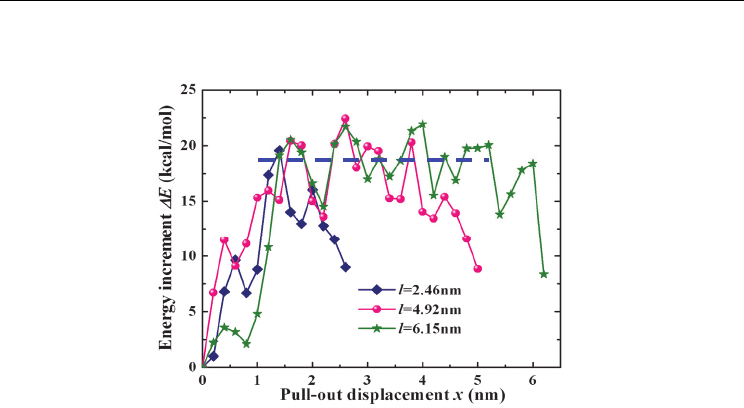
Reinforcement Effects of CNTs for Polymer-Based Nanocomposites
139
change in the magnitude of the platform stage II related to the stable CNT pull-out, which
indicates that
E
II
is independent of nanotube length.
Fig. 10. Effect of nanotube length on energy increment of SWCNT(5,5)
Due to this length-independent behaviour of
E
II
, the length of l
0
=3.44nm was employed for
all CNTs in the following simulations.
3.1.4.2 Effect of nanotube diameter
The energy increment
E corresponding to the pull-out of several SWCNTs with different
diameters are illustrated in Fig. 11a, which increases with nanotube diameter. Both
E and
E
II
were found to increase linearly with nanotube diameter D as shown in Fig. 11b, which
can be fitted as follows:
E=277.79D+62.39 (1)
E
II
=19.29 D+4.27 (2)
where D has the unit of nm,
E and
E
II
have the unit of kcal/mol. This linear correlation
can be explained by the increase of interfacial atoms accompanied with the increase of
nanotube diameter. Note that the formula of Eq. (1) for calculating the pull-out energy is
only applicable for the pull-out of CNT with the length of l
0
=3.44nm, in contrast to the
length-independent behaviour of
E
II
. In view of that
E increases with nanotube length,
for a real SWCNT with length of l
r
which is far longer than the present length l
0
,
E can be
estimated as follows
E*=
E+
E
II
(l
r
-l
0
)/
x (l
0
<l
r
) (3)
where l
r
is of the unit of nm, and the displacement increment here is
x=0.2nm. Note that
E represents the pull-out energy of SWCNT with length of l
0
=3.44nm which can be
calculated by Eq. (1).
In a word, the average increment in stage II (
E
II
) during the pull-out process of the
armchair SWCNT from polymer matrix, corresponding to the interfacial properties between
CNT and polymer matrix, is independent of nanotube length, but proportional to nanotube
E
II

Carbon Nanotubes – Polymer Nanocomposites
140
(a) Variation of energy increment (b) Dependence of energy increment on diameter
Fig. 11. Effect of nanotube diameter on energy increment of SWCNT(5,5)
diameter, which is similar to that for the sliding among nested walls in a MWCNT [Li et al.,
2010]. Moreover, by using Eqs (1-3), the pull-out energy
E and average energy increment
in stage II
E
II
for the pull-out of any armchair SWCNT can be predicted.
3.1.4.3 Effect of wall number
To investigate the effect of wall number n, three MWCNTs with different wall number were
embedded in PE matrix: SWCNT(15,15) with n=1, DWCNT(15,15)/(10,10) with n=2, and
TWCNT(15,15)/(10,10)/(5,5) with n=3. The corresponding nanocomposites are referred to
as: SWCNT/PE, DWCNT/PE, TWCNT/PE, respectively. Note that the above three CNTs
have the same outermost wall with diameter of D
0
=2.03nm and length of l
0
=3.44nm.
The corresponding energy increment
E are plotted in Fig. 12, whose average value in stage
II (
E
II
) are listed in Table 4. From this table, it can be found that the
E
II
for DWCNT/PE is
about 20% higher than that for SWCNT/PE. However, there is only a minor change of
E
II
between DWCNT/PE and TWCNT/PE. The reason can be explained by the increase of
distance between newly inserted inner walls and the interface. As the vdW interaction is
mostly dependent on the distance, the longer the distance is, the weaker the induced vdW
interaction is.
Fig. 12. Effect of n on energy increment
E
II
E
II
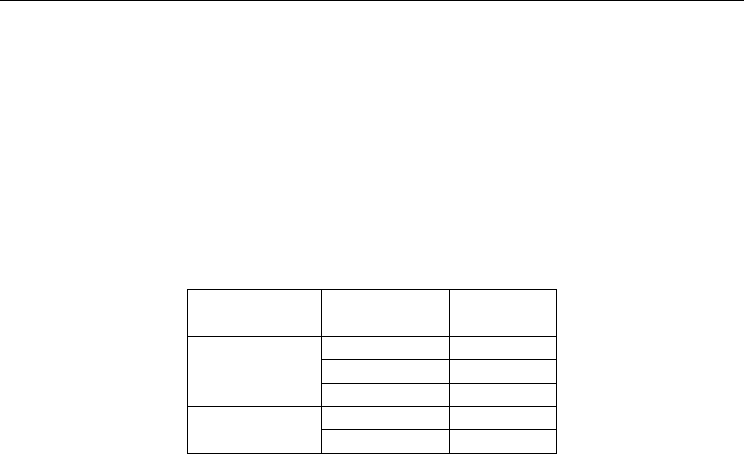
Reinforcement Effects of CNTs for Polymer-Based Nanocomposites
141
Therefore,
E
II
for the MWCNT (n≥2) pull-out can be approximately estimated as 1.2 times
of that for corresponding SWCNT, which is actually the outermost wall of the MWCNT. To
some extent, this finding is consistent with the reports of Schadler [Schadler et al., 1998] who
concluded that only the outer walls are loaded in tension for CNT/Epoxy nanocomposites
based on the observation of Raman spectrum.
Moreover, the calculated energy increment in the present simulation on the CNT pull-out
from polymer matrix is compared with the reports [Li et al., 2010] on the pull-out of
outermost wall in the same MWCNT as listed in Table 4. Obviously, the former is smaller
than the latter. It may indicate that even for some CNTs with fractured outer walls in the
CNT/PE nanocomposites, the CNT is easier to be pulled out from matrix instead of that the
fractured outer walls are pulled out against the corresponding inner walls.
Model
E
II
(kcal/mol)
CNT Pull-out
from PE
SWCNT/PE 43.07
DWCNT/PE 51.13
TWCNT/PE 52.71
Pull-out of the
outermost wall
DWCNT 55.11
TWCNT 59.32
Table 4. Comparison of
E
II
for two types of pull-out
3.1.5 Pull-out force
In practical CNT/Polymer nanocomposites, the real pull-out force can be contributed from
the following factors [Bal & Samal, 2007; Wong et al., 2003]: vdW interaction between CNT
and PE matrix, possible chemical bonding between CNT and PE matrix, mechanical
interlocking resulted by local non-uniformity of nanocomposites, such as waviness of CNT,
mismatch in coefficient of thermal expansion, statistical atomic defects, etc. Consequently,
the pull-out force can be divided into two parts, i.e., F=F
vdW
+F
m
. Here, F
vdW
is the component
for overcoming the vdW interaction at the interface which can be calculated by the
following Eq. (4); and F
m
is the frictional sliding force caused by the other factors stated. The
magnitudes of these two parts strongly depend on the interfacial state and CNT dimension.
For almost perfect interface, F
vdW
dominates the pull-out force. On the other hand, for the
case of chemical bonding or mechanical interlocking, which in general occurs easily for large
CNTs, F
m
mainly contributes to the total pull-out force. In the present study, only F
vdW
and
the related ISS for perfect interface are considered as mentioned in the beforehand work.
According to that the work done by the pull-out force at each pull-out step is equal to the
energy increment of nanocomposites, the corresponding pull-out force for the stable CNT
pull-out stage should be also independent of nanotube length, but proportional to nanotube
diameter, just as energy increment is.
From the obtained energy increment
E
II
in Eq. (2) and pull-out displacement increment of
x=0.2nm, we can get the pull-out force as follows:
F
II
=
E
II
/
x=
(0.67D+0.15) (4)
where F
II
and D have the units of nN and nm, respectively. The value of
represents the
effect of wall number, which is 1.0 for SWCNT and 1.2 for MWCNT with consideration of
the contribution of the inner walls.
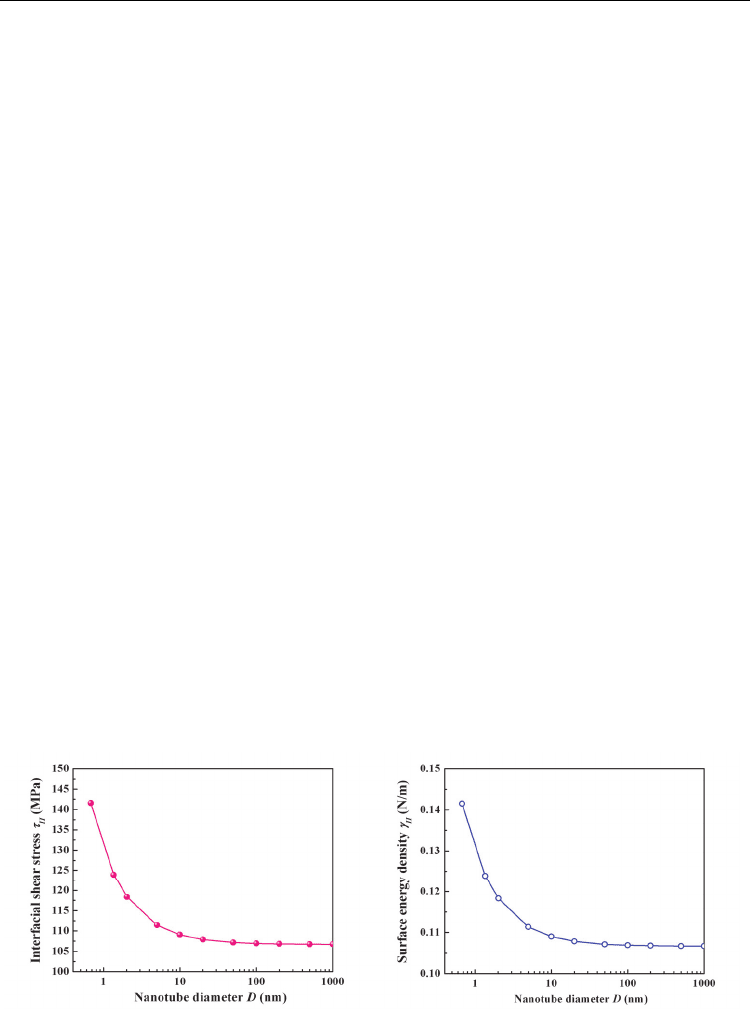
Carbon Nanotubes – Polymer Nanocomposites
142
3.1.6 Interfacial shear stress (ISS) and surface energy density
Based on the above discussions, the corresponding ISS and surface energy density are
analyzed in the following.
The pull-out force is equilibrated with the axial component of vdW interaction which
induces the ISS. Conventionally, if we employ the common assumption of constant ISS with
uniform distribution along the embedded CNT, the pull-out force F
II
will vary with the
embedded length of CNT, which is obviously contradict with the above length-independent
reports of
E
II
. For the extreme case of CNT with infinite length, the ISS tends to be zero,
which is physically unreasonable. This indicates that the conventional assumption of ISS is
improper for the perfect interface of CNT/PE nanocomposites. Therefore, in view of the
above characteristic of the variation of energy increment
E
II
, such as that the range of stage
I or stage III is around 1.0nm, it is concluded that the ISS is distributed solely at each end of
embedded CNT within the range of a=1.0nm at the beginning of stage II or the end of stage
I. In view of the dependence of vdW force upon the distance between two atoms, the ISS at
each end of the embedded CNT which is induced by the variation of vdW force, should at
first increase sharply and then decrease slowly to zero after reaching the maximum. Here,
by assuming its uniform distribution within two end regions for simplicity, the effective ISS
can be derived as
II
= F
II
/(2Da) (5)
By using Eqs. (1-5), the pull-out energy
E, the average pull-out force F
II
and the ISS
II
for
CNT/PE nanocomposites can be calculated. As shown in Fig. 13a, the calculated ISS is
found to decrease initially with nanotube diameter and saturate at the value of 106.7MPa for
SWCNT/PE nanocomposites. For MWCNT/PE, the saturated value is 128MPa, which is
about 1.2 times of that for SWCNT/PE, both of which has the same outermost wall.
On the other hand, in view of that two new surface regions are generated at the two ends of
CNT after each pull-out step, the corresponding surface energy should be equal to the
energy increment
E
II
by neglecting thermal dissipation. Therefore, the surface energy
density can be calculated as
II
=
E
II
/(2D
x)=F
II
/(2D) (6)
(a) Interfacial shear stress (ISS) (b) Surface energy density
Fig. 13. Dependence of ISS and surface energy density on nanotube diameter
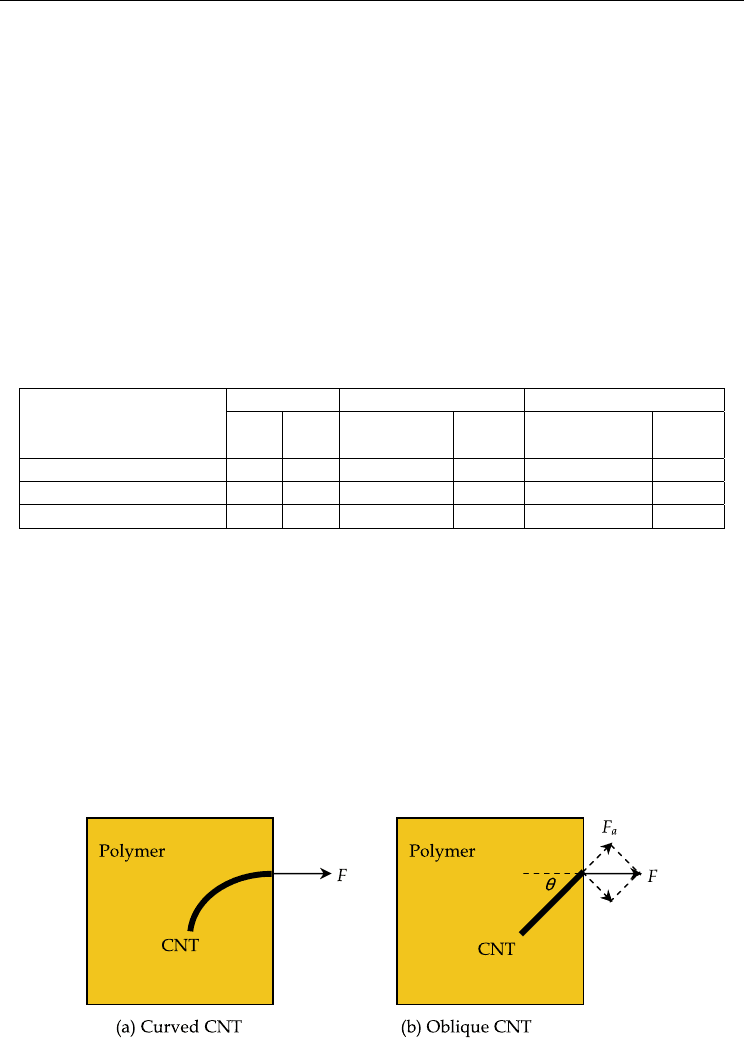
Reinforcement Effects of CNTs for Polymer-Based Nanocomposites
143
As shown in Fig. 13b, the surface energy density has the same trend as the ISS, which
initially decreases slightly as nanotube diameter increases and finally converges at the value
of 0.11N/m. This value is very close to the previous reports of 6-8meV/Å
2
(i.e., 0.09-
0.12N/m) [Lordi & Yao, 2000] and 0.15 kcal/molÅ
2
(i.e., 0.1 N/m) [Al-Ostaz et al., 2008] for
SWCNT/PE nanocomposites, which indicates the effectiveness of the present simulation.
3.1.7 Comparison with previous reports
The predicted ISS in the present study as given in Table 5 is obviously higher than that in
the previous reports [Frankland et al., 2002; Zheng et al., 2009; Al-Ostaz et al.] which is
calculated from
=2
E/(Dl
2
) (7)
The reason of this big difference is that the assumption of the constant ISS with uniform
distribution along the total embedded length of CNT employed in previous numerical
simulation, which has been verified to be unreasonable here.
Ref.
SWCNT Experimental reports Present prediction
D
(nm)
l
(nm)
E*
(kcal/mol)
*
(MPa)
E*
(kcal/mol)
(MPa)
[Frankland et al., 2002] 1.36 5.3
2.7
707.4 123.9
[Zheng et al., 2009] 1.36 5.9 ~500 33
798.8 123.9
[Al-Ostaz et al., 2008] 0.78 4.2 224 133
352.2 137
Table 5. Prediction in previous simulations for SWCNT/PE nanocomposites
For the pull-out force, the calculated values using the proposed formulae of Eqs.(1-4) are
compared with that reported in direct CNT pull-out experiments at nano-scale from several
different polymer matrices, as shown in Table 6. Obviously, the reported pull-out forces are
much higher than the calculated values only when vdW interactions are considered at the
interface between CNT and polymer matrix, although severe experimental data scattering
has been observed which may be caused by manipulation process or force/displacement
measurement. The reason can be attributed to the following factors.
Firstly, if we take into account the curvature of CNT (Fig. 14a), the necessary pull-out force
will increase. Considering a special case with the highest probability where an inclined
angle
between the axial direction of CNT and the pull-out direction is 45˚(Fig. 14b), the
Fig. 14. Simplified model for the pull-out of curved and oblique CNT
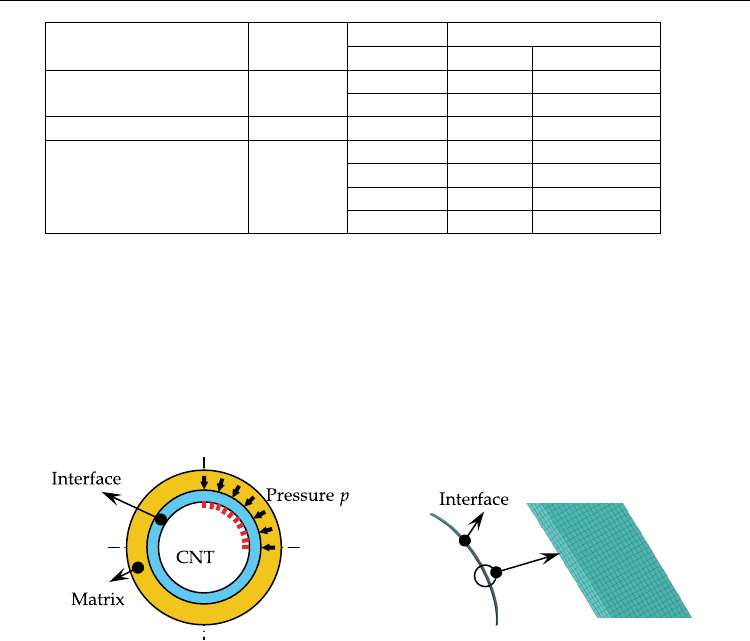
Carbon Nanotubes – Polymer Nanocomposites
144
Ref. Matrix
MWCNT
Pull-out force (N)
D (nm) Exp. Prediction
[Deng, 2008] PEEK
49 1.04 0.04
89 8.6 0.07
[Barber et al., 2003] PE-butene 80 0.85 0.07
[Cooper et al., 2002] Epoxy
8.2 3.8 0.01
11 2.8 0.01
13.4 0.6/2.3 0.01
24 6.8/12.8 0.2
Table 6. Prediction of previous experiments for MWCNT/Polymer nanocomposites
corresponding pull-out force will increase about 40%. By observing the data in Table 6, this
increase effect is still too small compared with the experimental data.
Secondly, for the effect of the pressure or residual stress in nanocomposites, a simple
representative volume element (RVE) model (Fig. 15a) was constructed to perform FEM
analysis. This continuum mechanics based computation is valid, at least qualitatively when
the diameter of CNT is over several tens of nanometers. Assuming the symmetrical
structure, the quarter part of interface region (i.e. the blue part in Fig. 15b) was employed.
(a) Simplified composite model (b) FEM model of interface
Fig. 15. Simplified FEM model of interface between CNT and matrix
The inner wall surface of the interface region was fixed as boundary condition, which
represents the rigid CNT. The uniform static pressure was applied on the outer wall of
interface region. Two values of Young’s modulus E
i
for the interface region were
considered, i.e., 1GPa and 3GPa. The corresponding FEM model is shown in Fig. 15b, where
the size of element size was taken as 0.05nm for convergence and accuracy.
The relationship of strain energy density
and the applied pressure p is shown in Fig. 16, in
which strain energy increases by the power of square with p. It can be found that a large
pressure p can only cause very small increase of strain energy density
, which indicates that
the effect of pressure or residual stress is not as strong as we expected. In general, the
residual stress in polymer nanocomposites ranges from 25.0MPa to 40.0MPa. For instance,
for the case of E
i
=1GPa of interface region, by applying for the pressure of 30.0MPa, the
strain energy density is around 2.8510
-5
N/m, which is still much smaller than the surface
energy density of
II
=0.11N/m caused by vdW interaction as stated previously. It means that
the pressure or residual stress in polymer nanocomposite system is not a dominant factor.
The above discussion leads to an important conclusion, i.e., the interface properties between
CNT and polymer matrix contributed by vdW interaction is quite minor for the real
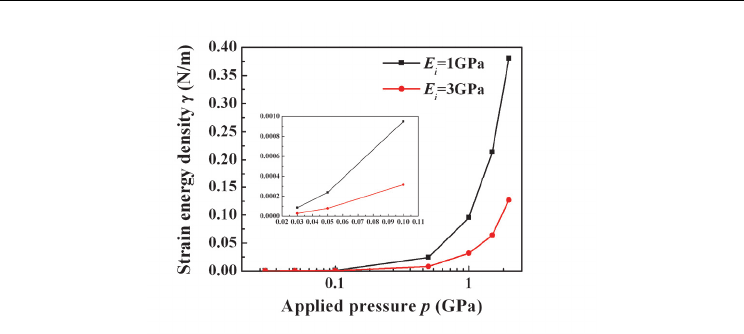
Reinforcement Effects of CNTs for Polymer-Based Nanocomposites
145
Fig. 16. Relationship between applied pressure and strain energy density
CNT pull-out from polymer matrix. Therefore, to accurately evaluate the interfacial
properties for real case, it is necessary to incorporate the effects of frictional sliding caused
by mechanical interlocking, atomic statistical defects, or chemical bonding. Moreover, for
effectively improving the interfacial properties and therefore the mechanical properties of
bulk nanocomposites, it is vital to incorporate into chemical bonding and mechanical
interlocking, which will be the topic in the future.
Note that although the type of polymer will influence the value of ISS which is not
discussed in the present work, the characteristics of pull-out force and the corresponding ISS
will be similar to those discussed in CNT/PE nanocomposites here.
3.2 Characterization on overall mechanical properties of CNT/Polymer
nanocomposites
To investigate the overall mechanical properties of CNT/Polymer nanocomposites, tensile
tests and SENB tests were carried out, in which MWCNT-7 and VGCF
®
were used as
reinforcement filler, respectively. Moreover, a sequential multi-scale model was developed
by incorporating the interfacial properties between CNT and polymer matrix obtained from
previous pull-out simulations into the conventional continuum theory, which connects the
interfacial properties to overall mechanical properties of CNT/Polymer nanocomposites.
3.2.1 Mechanical tests for CNT/Epoxy nanocomposites
Epoxy resin jER806 (Japan Epoxy Resins Co., Ltd., Japan) and the hardener Tohmide-245LP
(Fuji Kasei Kogyou Co., Ltd., Japan) were used to prepare the polymer matrix with the
weight ration of 100:62. According to the weight fraction W
f
of reinforcements, two groups
of nanocomposites were fabricated: MWCNT/Epoxy with W
f
of MWCNT-7 varying at 2, 3,
4%, and VGCF/Epoxy with W
f
of VGCF
®
varying at 2, 4, 6%. The fabrication process as
shown in Fig. 17 is described below:
1. The epoxy resin was first heated to 60˚C in an oven to decrease the viscosity for its
better miscibility with MWCNTs;
2. Then the CNTs were dispersed into the epoxy resin using the planetary centrifugal
mixer at 2000rpm for 10min;
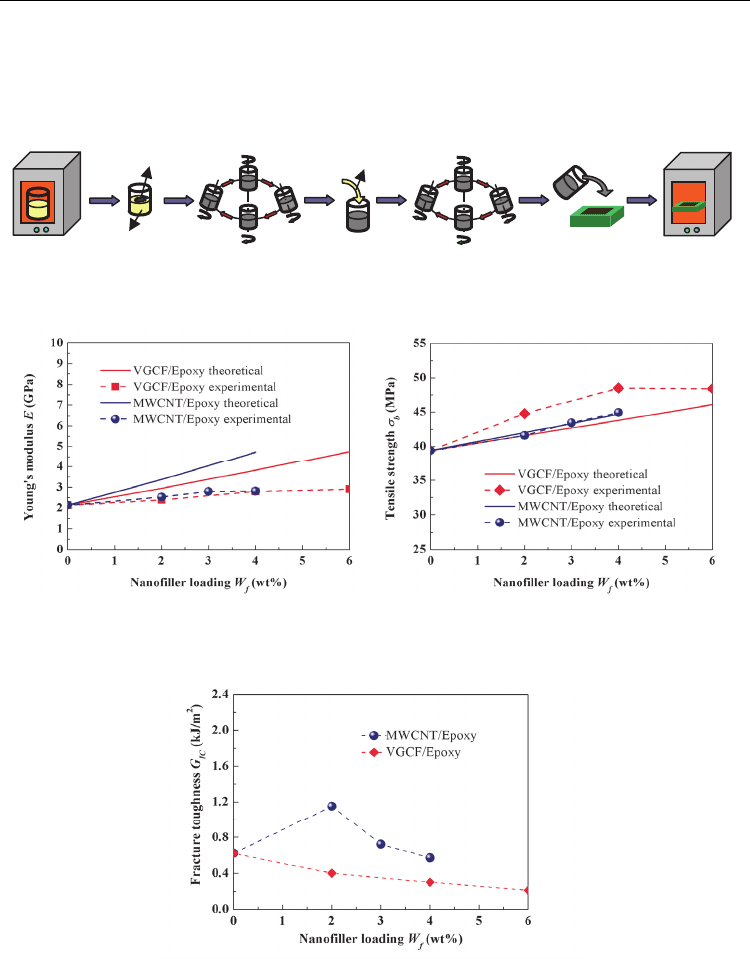
Carbon Nanotubes – Polymer Nanocomposites
146
3. After adding the hardener, the mixture was agitated for another 10 min at 1000rpm;
4. Subsequently, the mixture was poured into the silicon mould for a pre-curing process
with 12h at room temperature, followed by a post-curing process which was performed
at 80˚C in the oven for 6h.
Fig. 17. Fabrication of MWCNT/Epoxy nanocomposites for mechanical tests
(a) Young’s modulus (b) Tensile strength
Fig. 18. Comparison of theoretical and experimental Young’s modulus and tensile strength
Fig. 19. Experimental fracture toughness
According to ASTM D638 (Type V) and ASTM D5045 standards, tensile tests and SENB tests
were preformed. Three specimens of the above fabricated composites at a specified CNT
loading were prepared. A universal materials testing machine (Instron 5567) was used with
Epox
y
MWCNT
Hardener
